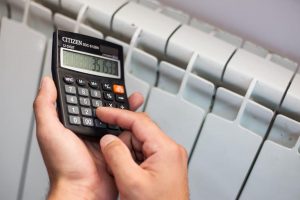
More and more private houses’ owners are thinking about ways of reducing the amount of utility bills and facade insulation. As experts say, the way of facade insulation can decrease the heat loss of a private house to 30%, which will positively affect the family budget. Such investments will make accommodation more comfortable and seriously reduce the amount of utility bills in future. Before you make a choice in favor of this or that insulation, it’s necessary to consider the kind of material your house was built with.
The private house insulation
Facade insulation of a private house is the most approachable and effective way of energy saving. It will help with solving such problems:
1. Defend walls of a private house from the negative environment influence.
2. Move dew point from the walls to insulation and in a result prevent the appearance of mold and fungus in the house.
3. Provide the maximum heat retention in rooms.
4. Is fireproof (at insulation with the mineral wool);
5. Provide good soundproofing and let one feel comfortable.
Dew point depends on two indicators: temperature and humidity. In winter, when temperature and humidity in rooms are higher than outside, moisture will condense from the steam when moving from the inside-out. If the wall isn’t insulated, dew point will be placed in the wall and shift to one or another side according to the temperature and humidity. In this case, it will be damp indoors. So, while choosing insulation for a private house, it’s very important to note its type, thickness and vapor permeability with the purpose of locating dew point in insulation and then the indoors will save heat.
Usually, the service life of insulation is from 25-35 years. It’s the term at which insulation won’t lose its properties and will allow you to live comfortably in the house.

What is best for facade insulation
Today all owners of private houses understand the necessity of insulation housing, because prices of energy carriers constantly grow. Main criterion in choosing good insulation is its low thermal conductivity.
Also, important aspects to pay attention to are:
• Term of utility;
• Strength of material;
• Moisture proof of insulation;
• Exposure to rodents and other animals attack;
• Presence of organic and non-organic components at the core.
The most popular kinds of insulation today remain:
• Mineral wool
• Basalt wool
• Glass-wool
• Expanded polystyrene
• Styrofoam
• Extruded polystyrene foam
• Sprayed insulation
At compiling this rating, the following criteria were taken into account:
• Price availability;
• Technical characteristics;
• Scope of application;
• Experts thoughts;
• Users reviews.
1. Mineral wool
It is a very practical material with a high fiber. Contains mineral fibers and its composition is close to asbestos fiber. Two materials are used for production of mineral wool: volcanic rocks and slag.
Main characteristics of this material are:
• High resistance to chemicals
• Long service life up to 50 years
• Resistance to high temperatures
• Fire safety
• Provides free air circulation
• Good sound absorption
Significant disadvantage when choosing this material is the fact of containing harmful substances in its composition. However,with correct installation it is possible to avoid the ingestion of harmful substances.
Each of these kinds of insulation we will consider in detail.

1.1. Basalt wool for facade
Basalt wool is natural material from the rock of the grobb-basalt group. It’s ecological and able to withstand temperatures over 100°C. Refers to non-combustible materials. Has high indicators of heat and soundproofing. Is not influenced by mechanical, chemical and biological impacts. Subject to installation standards, it doesn’t absorb moisture.
Basalt wool is produced by high temperature processing of rocks. The manufacturing technology consists in melting rocks at a temperature of 1500°C. After that, liquid substance is drawn into stone fibers using a centrifuge, special filters and strong air currents. Different water-repellent additives and plasticizers are added into the resulting fibers, after which at temperature of 200°C there is a process of polymerization and we’re receiving finished basalt slabs, which are cut in accordance with the required size.
Main characteristics of the material are:
1. Effective thermal insulation
2. Resistance to deformation
3. Hydrophobicity
4. Good sound absorption
5. Fire safety
Significant disadvantage when choosing this material is its high cost compared with other kinds of insulation. Despite this, basalt base gives the material unique properties and many owners of private houses choose this particular material for insulation.

1.2. Glass wool
Glass wool is a variety of mineral wool. It is a fiber mineral heat proofing material(fiberglass), which is obtained from the raw materials during the manufacture of ordinary glass, or waste from the glass industry. Glass wool has high resistance to chemicals, its density in a loose state doesn’t exceed 130 kg/m³.
Glass wool properties are different compared with other types of mineral wool. Glass wool fiber has a thickness of 3-15 microns, and the length is at least 2-4 times longer than that of stone wool. Because of this glass-wool products have higher elasticity and strength. It contains almost no non-fibrous inclusions and is highly vibration-resistant.
Thermal conductivity — 0,030…0,052 W/mK.
Glass wool temperature resistance — 450 °C.
Main characteristics of the material are:
1. Effective thermal insulation
2. Increased elasticity and strength
3. High vibration-resistance
4. Well suited for cladding uneven surfaces
5. Low cost
Main disadvantage of glass-wool is high fiber fragility, sharp and thin debris of which easily enter human clothes, eyes and skin and are itchy. Besides, breathing glass wool fibers debris can cause long-term lung irritation.
Work with glass wool should be held in tight overalls, without open areas of the body, tarpaulin gloves, respirator and goggles.
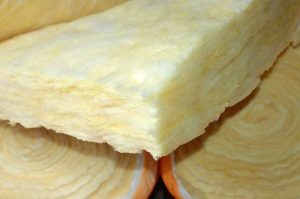
2. Insulation of the facade of the house with expanded polystyrene
Facade insulation with expanded polystyrene is the most popular kind of external thermal insulation due to its availability and cheapness. This material has undergone many challenges and improvements.
Main characteristics of the material are:
● Reduced heat conductivity
● High strength and durability
● Increased moisture-repellent properties
● Resistance to biological and chemical impacts
● Self-extinguishing ability
One of the main disadvantages of this kind of insulation is the fact that this material belongs to the flammability group G1. Toxic material.
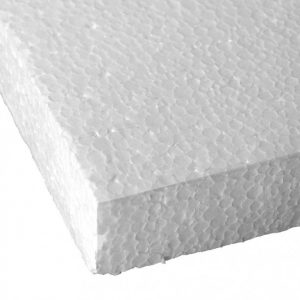
2.1. Insulation of the facade of the house with styrofoam
Styrofoam is a foamed plastic material. Because of the fact that the main volume of styrofoam is taken by gas, density of styrofoam is essentially lower than density of its original raw material (polymer). This causes relatively high thermal insulation properties and sound proofing properties of this material.
Main characteristics of the material are:
● High thermal insulation properties
● Not affected by microorganisms
● Non-toxic material
● Simple and convenient at installing
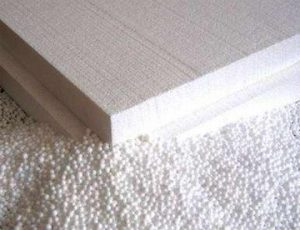
2.2. Insulation of the facade of the house with extruded polystyrene foam
Extruded polystyrene foam (XPS) — synthetic thermal insulation material, which is manufactured by extrusion.
Extruded polystyrene foam is obtained by mixing polystyrene granules at an elevated temperature and pressure with the input of a blowing agent and subsequent extrusion from the extruder.
Qualitative extruded polystyrene foam has an even, closed-porous structure.
Main characteristics of the material are:
● Low heat conductivity (0,029-0,034)
● Minimum water absorption (0,2-0,4 %)
● Low specific gravity (25..45 kg/m³)
● High thermal insulation properties
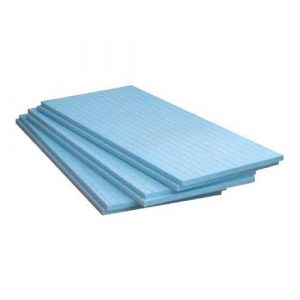
The disadvantages of extruded polystyrene foam refers to its high flammability by groups G3-G4. Combustion product toxicity indicator – moderately hazardous (T2).
3. Sprayed insulation (polyurethane foam)
Polyurethane foam is a group of materials of gas-filled plastics, on the base of polyurethanes, which consist of 90% of the inert gas phase. As starting components, polyurethane usually uses petrochemical products (polyols and polyisocyanates), but it’s also possible to develop components from vegetable oils. High adhesion rates make this material versatile. Widely used as a heat and soundproofing. Opportunity to manufacture and apply polyurethane foam directly at the construction site essentially reduces associated costs.
Main characteristics of the material are:
● High soundproofing
● Heat resistance
● Good heat conductivity
● Waterproofing properties
● High adhesion
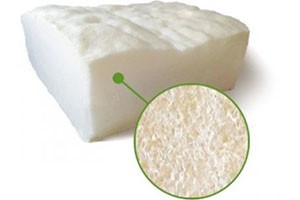
Kind of implementation of insulation
1. Hinged ventilated facade
Hinged ventilated facade for the house is a unique construction of cladding of the facade of the building, which consists of a few main elements, among which subsystem or framework is the most important. Framework can be made of galvanized steel, wood.
Subsystem includes not only metal elements, but also all manner of fasteners in the form of dowels, anchors, hardware, etc. With fastener elements, a layer of external cladding, namely: metal cladding, PVC, wood, porcelain stoneware, etc., is installed over the framework.
Main characteristics and advantages of this method are:
● Unique design
● Good soundproofing
● Providing reliable protection of a private house from moisture
● Installation work at any time of the year
● Low load on the supporting structures of the facade
● Effective thermal insulation
● Fire safety
● Weathering of moisture from the insulation while preserving the properties of the insulation itself
The component parts of a facade sandwich consist of:
● Protective and decorative material, which can be chosen from variety colors and it’s fastened with metal crews to the crate (cladding);
● Framework with fasteners;
● Insulation layer;
● Ventilation gap.
Cladding types:
● PVC
● Metal
● Wood
● Aluminium panels
● Ceramic sand panels
The most important part of any ventilated facade is an insulation layer. It provides comfortable temperatures indoors and allows to save energy costs required for normal house operation.
As an insulation layer only non-combustible materials should be used.
The most effective insulation for ventilated facade:
● Basalt wool
● Glass wool
They are made from the environmentally friendly natural materials using heat treatment and completely with technical requirements. Styrofoam isn’t recommended while installing ventilated facades. It burns with the release of toxic materials and doesn’t allow the condensate to air out.
Ventilated facades are the most demanded and advanced from the technical point of view. Compared with other kinds of insulation, the use of flammable insulation isn’t allowed in ventilated facades. Panel and hinged ventilated facades are considered to be the most safe, subject to technology and material requirements.
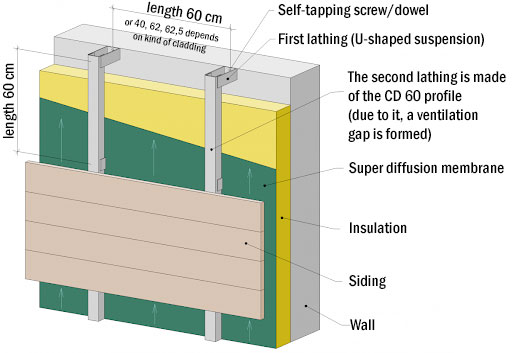
2. Facade plaster (wet facade)
This material has been used in construction for a long time. It gained such popularity due to the fact that at that time there was no alternative on the market. On today facade plaster provides imitation of the look and structure of any material. Besides, there are also ready mixes on the market, which significantly simplify the preparation for plastering. Good advantage is the fact that the plaster can be painted in any color at the request of the customer. However, a significant disadvantage of this material is its dependence on weather conditions during application. At the temperature from -10°C and +30°C facade plaster is forbidden to apply, as opposed to siding, which hasn’t seasonal restrictions at installation.
As an insulation layer use:
● Styrofoam
● Extruded polystyrene foam
● Basalt wool.
Advantages of this method:
● One of the cheapest way of insulation
● for finishing the facade – any decor according to customer references
● Small weight
Disadvantages of this method:
● Short-lived. Average, after 3-5 years repairs needed;
● Application works can be carried out only at positive air temperature;
● Strict requirements to ambient humidity;
● The presence of smooth walls;
● In case of damage – expensive restoration of ‘cake’;
● For owners of private – rodents spoil the material;
● Failure to comply with the recommendations for the performance of work reduces the quality of its performance;
● At compliance of all requirements of ‘cake’ technology cost increases;
● High requirements for the professionalism of the assembly team and accordingly the cost of work is higher, than at assembling a ventilated facade.
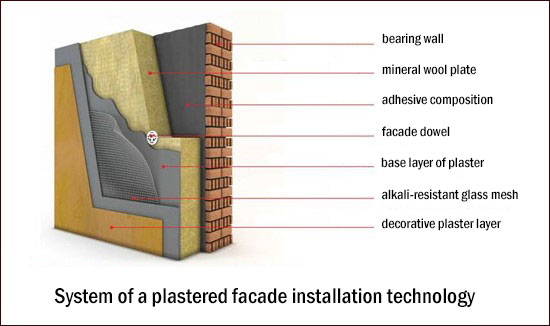
3. House cladding with siding
Insulation has its advantages and disadvantages, but it also needs to be protected from external impact. One of the variants of protection is siding installation. It represents panels, fastened to the crate. And additionally protects insulation and walls from agressive weather conditions.
Panels in turn are divided depending on the material from which they were made:
● Vinil;
● Acrylic.
Main characteristics and advantages of this material are:
● Service life from 20 to 50 years
● Energy efficiency
● Simple installation (you can do it yourself)
● Small weight
● Easy care
● Various design options
As a layer of thermal insulation used:
● Glass wool
● Basalt wool
● Polyurethane foam
In order of insulation serving for a long time, the following factors are needed to take into account:
1. Moisture resistance
2. Incombustibility
3. Indicator of heat conductivity
4. Environmental safety
5. Simplicity of installation
6. Longevity
We see that a large selection of insulation can be used for siding – at the request and budget of the client.
Among the companies on the market for the production of siding, Alta-Profil Ukraine is an unconditional leader. High product quality and long warranty will allow you to be confident in reliability and long service life of installed siding for your house.
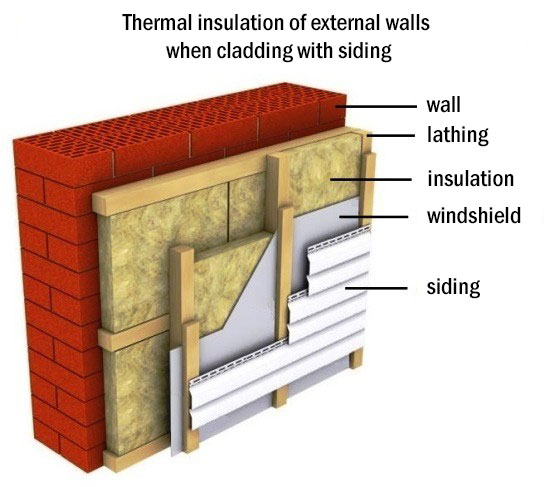
Siding or plaster, what is cheaper?
Work with siding is significantly easier and more convenient, than with facade plaster. If you decide to make a facade with a few variants of siding, it will be better to buy materials from one manufacturer company, Alta-Profil Ukraine. In comparison to prices, expanded polystyrene plaster will cost you less than siding, but such characteristics like longevity, color fastness, thermal insulation properties of siding will be higher and more reliable.
| Characteristics | Hinged ventilated facades | Styrofoam/decorative plaster |
| Service life | To 50 years without repair | To 20 years, needs periodic repair |
| Installation convenience | Easy and fast installation at any time of the year. All elements made with high accuracy on factory | Requires qualified installation, excluding the appearance of cold bridges. Requires preparation of tha facade. Installation Only at a positive temperature. |
| Thermal insulation properties | Good | Good |
| Soundproofing properties | Excellent acoustic isolation | Satisfying acoustic isolation |
| Fire safety | Insulation refers to the group of non-combustible materials. Panels don’t keep burning | Styrofoam panels are susceptible to burning at the influence of open flame. Combustion products are highly toxic. Plaster does role of flame shield (if it isn’t violated) |
| Hygiene | During service life, materials fully meet hygiene requirements | During long service life, appearance of toxic decomposition products of styrofoam is possible |
| Vapor permeability | High. Condensate is removed, the house breathes | Low, environment moisturizes, which reduces thermal insulation characteristics |
| Strength | High impact strength of siding at any operation temperature from -50 to +60℃ of the external air | Fragility and probability of partly spontaneity destroying at temperatures of +80℃ (what is possible under plaster) and higher. Destroyed at impact of organic solvents |
| Color fastness | High color fastness of siding | Changing (burnout) the color of plaster |
| Biostability | Material isn’t affectable to microflora impact | Appearance of fungus and rodents is possible |
| Ease of use | Doesn’t require special care during 25 years | Requires periodic repair and replacement after 5-10 years |
The choice always depends on you, but it’s necessary to consider all characteristics and advantages of one material (siding) over another (plaster). Sometimes it’s worth paying a little more and receiving quality and long-term results than renovating the facade each 2-3 years.
Select facing materials:
• Siding
• Facade panels
• Fastening system




